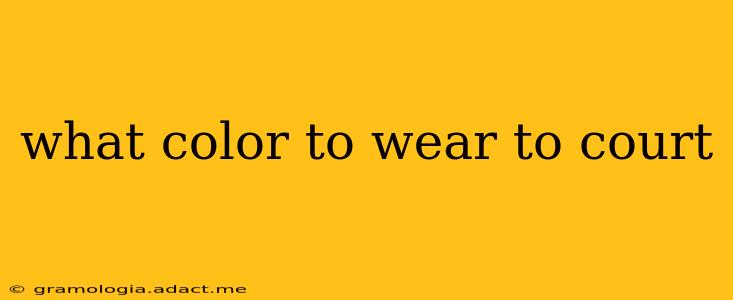What Color to Wear to Court: A Guide to Dressing for Success
Choosing the right outfit for a court appearance can feel daunting. While there's no single "correct" color, understanding the unspoken rules of courtroom attire can significantly impact how you're perceived. The goal is to project professionalism, respect for the court, and confidence – and your clothing plays a crucial role in achieving this. This guide will help you navigate the complexities of courtroom dress code, addressing common questions and offering practical advice.
What colors are generally considered appropriate for court?
Neutral and subdued colors are generally recommended for court appearances. Think navy blue, charcoal gray, or dark brown for suits. For women, a well-tailored pantsuit or skirt suit in these colors is appropriate. For men, a suit with a collared shirt and tie is generally the standard. These colors convey seriousness and professionalism without distracting the judge or jury. Avoid bright, flashy colors or bold patterns that might draw unwanted attention.
What colors should I avoid wearing to court?
Bright colors like bright red, neon green, or bright pink should be avoided. These can be perceived as disrespectful or overly attention-seeking. Similarly, avoid clothing with distracting patterns, logos, or slogans. White can sometimes be too stark and formal, depending on the context. Black, while often associated with professionalism, can sometimes appear overly serious or even funereal. Ultimately, the goal is to present a neutral and respectful appearance.
Are there any specific color restrictions depending on the type of court?
While the general principles remain consistent, the level of formality might vary slightly depending on the type of court. For example, a less formal setting, such as a small claims court, might allow for slightly more leeway in terms of color and style. However, it's always best to err on the side of caution and dress conservatively. It's always advisable to check with the court clerk or your attorney beforehand if you are unsure about the appropriate attire.
What if I'm a witness and not a defendant? Does the dress code still apply?
Yes, the dress code applies equally to witnesses. Even if you're not the defendant, presenting yourself professionally and respectfully is crucial to maintaining the integrity of the court proceedings. The judge and jury will form their initial impressions based on your appearance, so dressing appropriately can contribute to a positive and credible presentation.
How important is it to follow the dress code?
Following the court's unspoken dress code is incredibly important. Your clothing choices directly influence how the judge, jury, and other parties perceive you. A sloppy or inappropriate outfit can undermine your credibility and damage your case. By dressing professionally, you show respect for the court and demonstrate that you take the proceedings seriously. This can contribute significantly to a favorable outcome.
What if I can't afford a suit?
If you can't afford a suit, don't despair. Borrowing a suit from a friend or family member, visiting a local charity shop or thrift store, or even carefully choosing a well-fitting and clean pair of slacks or a skirt paired with a button-down shirt or blouse can be suitable alternatives. The key is to appear neat, clean, and well-groomed. Focus on presenting yourself as neatly and respectfully as possible within your means.
This guide offers general advice, and it's always recommended to check with the court clerk or your attorney for specific guidance. Remember, dressing appropriately demonstrates respect for the court and can significantly impact the perception of your case.
